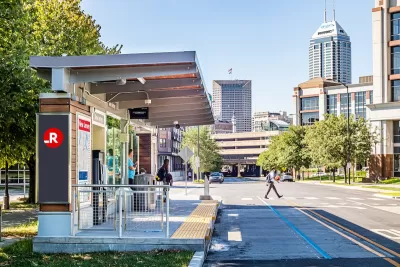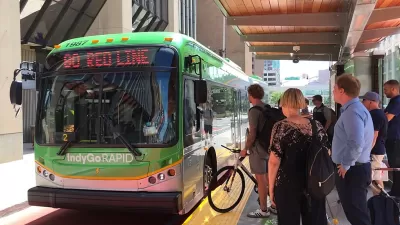The Blue Line will be the third bus rapid transit corridor in the city.

The Indianapolis Public Transportation Corporation (IndyGo) received a $149.9 million grant from the Federal Transit Administration (FTA) to support the construction of a new bus rapid transit (BRT) line that could reduce travel times along its corridor by up to 30 percent.
As David Gay reports for Fox 59, “Officials said the 24-mile project will ‘provide fast and frequent public transportation’ for one of the main east-west travel corridors in Marion County.” The line will run 20 hours per weekday to 30 stations.
The Blue Line will be the third and final planned BRT route in the city along with the Purple and Red lines, said IndyGo President Jennifer Pyrz. The total cost of the project is an estimated $396 million and is scheduled for completion in late 2028.
FULL STORY: IndyGo receives $149 million federal grant for Blue Line bus rapid transit project

Trump Administration Could Effectively End Housing Voucher Program
Federal officials are eyeing major cuts to the Section 8 program that helps millions of low-income households pay rent.

Planetizen Federal Action Tracker
A weekly monitor of how Trump’s orders and actions are impacting planners and planning in America.

The 120 Year Old Tiny Home Villages That Sheltered San Francisco’s Earthquake Refugees
More than a century ago, San Francisco mobilized to house thousands of residents displaced by the 1906 earthquake. Could their strategy offer a model for the present?

HSR Reaches Key Settlement in Northern California City
The state’s high-speed rail authority reached an agreement with Millbrae, a key city on the train’s proposed route to San Francisco.

Washington State Legislature Passes Parking Reform Bill
A bill that would limit parking requirements for new developments is headed to the governor’s desk.

Missouri Law Would Ban Protections for Housing Voucher Users
A state law seeks to overturn source-of-income discrimination bans passed by several Missouri cities.
Urban Design for Planners 1: Software Tools
This six-course series explores essential urban design concepts using open source software and equips planners with the tools they need to participate fully in the urban design process.
Planning for Universal Design
Learn the tools for implementing Universal Design in planning regulations.
Ada County Highway District
Clanton & Associates, Inc.
Jessamine County Fiscal Court
Institute for Housing and Urban Development Studies (IHS)
City of Grandview
Harvard GSD Executive Education
Toledo-Lucas County Plan Commissions
Salt Lake City
NYU Wagner Graduate School of Public Service




























